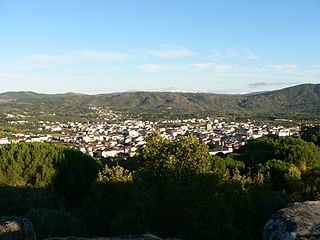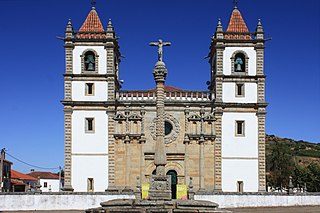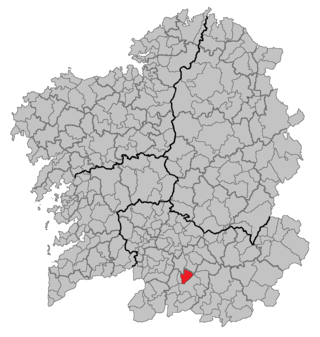
Galicia is an autonomous community of Spain and historic nationality under Spanish law. Located in the northwest Iberian Peninsula, it includes the provinces of A Coruña, Lugo, Ourense, and Pontevedra.

A hillfort is a type of earthwork used as a fortified refuge or defended settlement, located to exploit a rise in elevation for defensive advantage. They are typically European and of the Bronze Age or Iron Age. Some were used in the post-Roman period. The fortification usually follows the contours of a hill and consists of one or more lines of earthworks, with stockades or defensive walls, and external ditches. If enemies were approaching, the civilians would spot them from a mile away.

Pontevedra is a city in the autonomous community of Galicia, in northwestern Spain. It is the capital of both the Comarca and Province of Pontevedra, and the capital of the Rías Baixas. It is also the capital of its own municipality which is often considered an extension of the actual city.

Verín is a town and municipality in the southeast of the province of Ourense, autonomous community of Galicia, Spain. The population of the municipality is about 14,433. It is located 70 kilometers east of the provincial capital of Ourense and 15 kilometers north of the Portuguese city of Chaves. The Tâmega River flows through the town. In the Middle Ages it was known as Santa María de Verín.

Ourense is a city and the capital of the province of Ourense, located in the autonomous community of Galicia, northwestern Spain. It is on the Camino Sanabrés path of the Way of St James, and is crossed by the Miño, Barbaña, Loña and Barbañica rivers. It is also known as A cidade das Burgas due to its hot springs, being one of the European cities with the greatest thermal heritage.

Bragança, also known in English as Braganza, is a city and municipality in north-eastern Portugal, capital of the district of Bragança, in the Terras de Trás-os-Montes subregion of Portugal. The population in 2011 was 35,341, in an area of 1173.57 km².

A Coruña is a city and municipality of Galicia, Spain. It is Galicia's second largest city, only behind Vigo. The city is the provincial capital of the province of the same name, having also served as political capital of the Kingdom of Galicia from the 16th to the 19th centuries, and as a regional administrative centre between 1833 and 1982, before being replaced by Santiago de Compostela.

Galician–Portuguese, also known as Old Galician–Portuguese, Old Galician or Old Portuguese, Medieval Galician or Medieval Portuguese when referring to the history of each modern language, was a West Iberian Romance language spoken in the Middle Ages, in the northwest area of the Iberian Peninsula. Alternatively, it can be considered a historical period of the Galician, Fala, and Portuguese languages.

Lugo is a city in northwestern Spain in the autonomous community of Galicia. It is the capital of the province of Lugo. The municipality had a population of 98,025 in 2018, making it the fourth most populous city in Galicia.

Sandiás is a municipality of Galicia, Spain, next to Xinzo de Limia in the province of Ourense. Its estimated population is 1,585, distributed among 3 parishes. Its area is 53 km2, a great part of which is drained fields from the Antela lagoon. This is an agricultural area. Potatoes and cereals are the most important crop. Sand extractions are also important for local development.

Monforte de Lemos is a town and municipality in northwestern Spain, in the province of Lugo, Galicia. It covers an area of 200 km² and lies 62 km from Lugo. As of 2017 it had a population of 18,783.

The Iberian Peninsula, where Galicia is located, has been inhabited for at least 500,000 years, first by Neanderthals and then by modern humans. From about 4500 BC, it was inhabited by a megalithic culture, which entered the Bronze Age about 1500 BC. These people would become the Gallaeci, and they would be conquered by the Roman Empire in the first and second centuries AD. As the Roman Empire declined, Galicia would be conquered and ruled by various Germanic tribes, notably the Suebi and Visigoths, until the 9th century. Then the Muslim conquest of Iberia reached Galicia, although they never quite controlled the area.

Castro culture is the archaeological term for the material culture of the northwestern regions of the Iberian Peninsula together with the Spanish regions of Galicia, Asturias, and western León) from the end of the Bronze Age until it was subsumed by Roman culture. It is the culture associated with the Gallaecians and Astures.

Boimorto is a municipality in the province of A Coruña, in the autonomous community of Galicia, northwestern Spain. It is located in the comarca of Arzúa. It has an area of 82.71 km2, a population of 2,486, and a population density of 30.06 people/km2. Coordinates: 43° 00' 27" N - 8° 07' 37" W. Elevation: 487 m.

Cambre is a municipality in the Province of A Coruña, in the autonomous community of Galicia in northwestern Spain. It is located 12 km from the capital city of A Coruña and ten minutes away from the city's airport, Alvedro.

Carballo is a municipality in the province of A Coruña, in the autonomous community of Galicia, in northwestern Spain. The town is the thirteenth most populated municipality in the region and it belongs to the comarca of Bergantiños, serving as its capital.

Galicians are a European ethnic group from northwestern Spain; it is closely related to the northern Portuguese people and has its historic homeland in Galicia, in the north-west of the Iberian Peninsula. Two Romance languages are widely spoken and official in Galicia: the native Galician and Spanish.

A Rúa is a mostly rural municipality in the province of Ourense, in the autonomous community of Galicia, Spain. It belongs to the comarca of Valdeorras. It is 101 km (63 mi) from the provincial capital, Ourense. An inhabitant of the area is known as a rués.

Narón is a municipality in northwestern Spain in the autonomous community of Galicia. It belongs to the comarca of Ferrol.
The history of the Galician language can be summarized as seven centuries of normality and five centuries of conflict. From its origins when it separated from the Galician Latin in the 9th century until the introduction of Castilian in the 16th century there was peace, and from the 16th century until the present there were various conflicts.






















